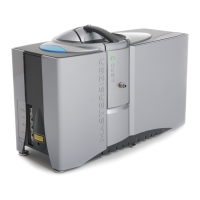Hardware features
34
Drain port and lever
The drain port is the exit point where sample/dispersant leaves the dispersion unit. A
warning triangle warns that the contents of the tank are drained from this pipe. The risk
depends on the hazardous nature of the dispersants/samples being measured.
Refer to the Connection of the dispersion units on page58, and the Site requirements in
the Mastersizer 3000 Basic Guide, for advice on positioning the drain/waste pipe.
The drain port is operated using the drain lever.
l The drain is closed when the lever is fully back, and upright.
l The drain is opened by moving the lever forward, and flat to the base.
Connecting the drain pipe
To connect the drain pipe:
1. Place the jubilee clip over the drain pipe.
2. Push the pipe over the drain port fitting.
3. Tighten the jubilee clip until fully secure.
Removal is the reverse of the procedure.
Note: Replacement drain pipes are available direct from Malvern Instruments.
To cell / From cell connections
The sample from the dispersion unit is circulated through the cell via ‘to cell’ and ‘from
cell’ connections and the connected sample pipes.
To cell connection
The ‘to cell’ connections on the dispersion unit and wet cell have yellow identifier marks.
The bottom connection on the dispersion unit connects to the sample 'out' pipe. This is
where the sample flows out of the dispersion unit in to the bottom ‘to cell’ connection of
the wet cell (yellow collar) in the optical unit.

